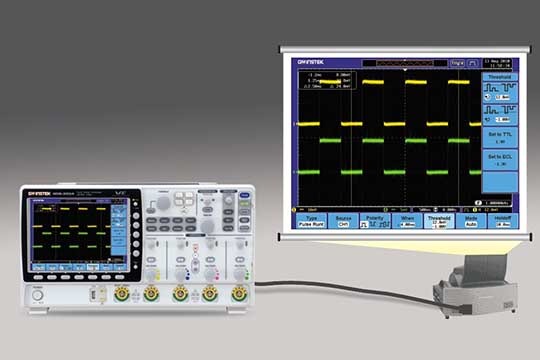Today switching power supplies (AC-DC or DC-DC) are widely used in various fields. The GW Instek GDS-3000 series Digital Storage Oscilloscope, with its power analysis software, can be used for power analysis of SMPS. It allows to measure power quality, harmonics, ripple and inrush current. These functions allow you to use an oscilloscope to easily obtain power analysis data without the cost of acquiring expensive test equipments such as power meters. The power analysis software functions are described below:
- Power Quality
When designing a switching power supply, engineers need to assess the quality of primary side. In reality, the voltage and current waveforms are not ideal sine waves and they contain distortion and abnormality. This abnormality affects power consumption, efficiency and reliability. As such, it’s important to measure power quality. The GDS-3000 power analysis software not only provides Apparent Power, True Power, Reactive Power and Power Factor but also contains other useful measurements associated with power quality.
- Harmonics
If a load is linear, then current and AC power would be an ideal sine wave without distortion. However if a load is nonlinear, like a rectifier load, the current waveform will be distorted. For example: If a voltage has a frequency of 50Hz, the distortion of the current waveform can be analyzed by the Fourier transform. The Fourier transform can decompose the current waveform into its fundamental frequency (50Hz), and its harmonic frequency components (100Hz, 150Hz…etc.). In recent years, the extensive use of rectifier loads has resulted in the emergence of a large number of harmonic currents, indirectly polluting voltage. To ensure the purity of the mains voltage, standards such as IEC61000-3-2 have been imposed to regulate power quality.
- Ripple and Noise
Ripple: The whole output noise of switching power supply can be viewed as the combination of ripple and noise. Ripple is the output voltage fluctuation caused by the charge and discharge of a switching mode power supply. Power supply noise, usually referred to as RMS noise, characteristically has a low peak-to-average ratio and occurs at the fundamental switching frequency. As ripple is caused by the discharging and charging of the input and output capacitors, ripple can be reduced by increasing the input and output capacitance.
Noise: High frequency noise spikes occur when switching mode power turns on or off. Although the repetition frequency of the noise is determined by the switching frequency, the frequency content of the noise spike is much higher than the switching frequency. The amplitude of noise spikes is highly dependent on the power supply topology, PCB layout and circuit parasitic.
- In-rush current
Inrush current, or surge current, from a switching mode power supply can be defined as the peak instantaneous current that is generated when the power supply is first turned on. The Inrush current is caused by filtering capacitors acting as short circuits when a power supply is first turned on. Engineers should note the inrush current generated at startup because a large inrush current can cause damage to the whole system.
Features
- 500/350/250/150MHz with 2/4 Channels
- 5GSa/s RT or 100GSa/s ET Sampling Rate
- Independent Memory for Each Channel
- VPO Technology
- Large 8-inch 800×600 Display
- Split Screen Function
- 3 Built-in Impedances (50Ω/75Ω/1MΩ)
- Power Analysis Software (Optional)
- Serial Bus Analysis Software for I2C, SPI and UART (Optional)
For more information about product, power analysis software, and its corresponding accessories, please visit our website: www.gwinstek.com or contact –
Sumit Sharma (Marketing Manager – India)
Mob No: +91-9999167300, E-mail: [email protected]















